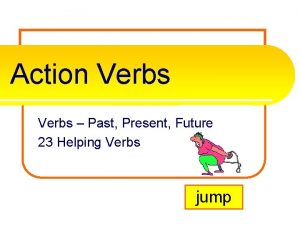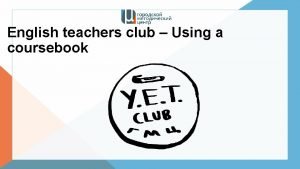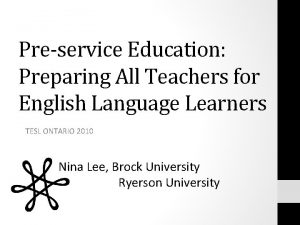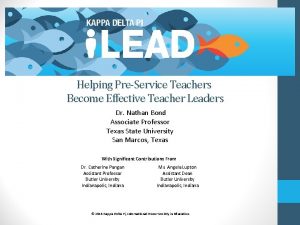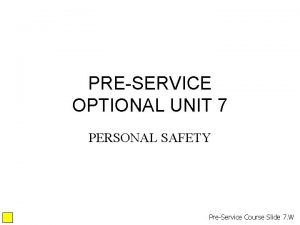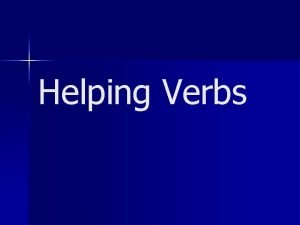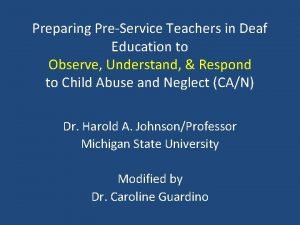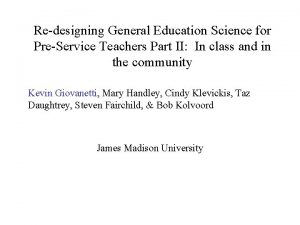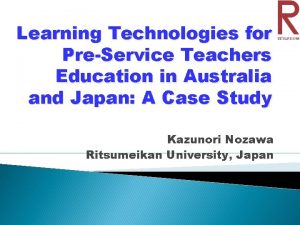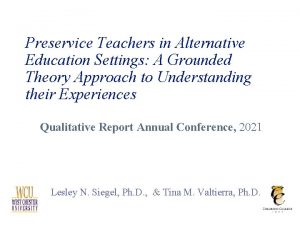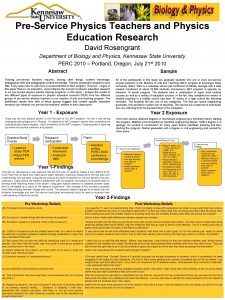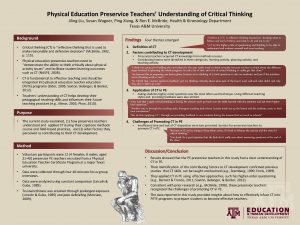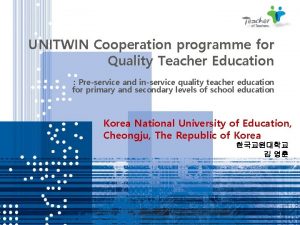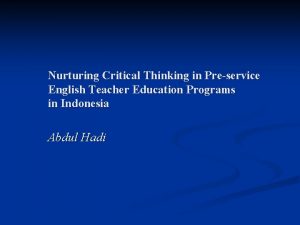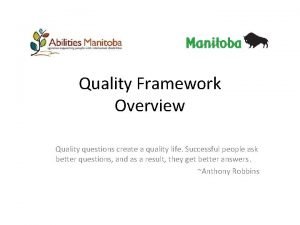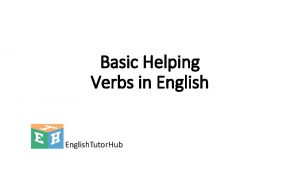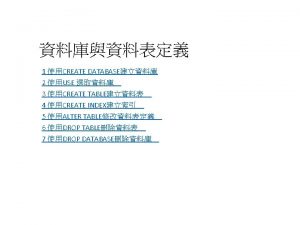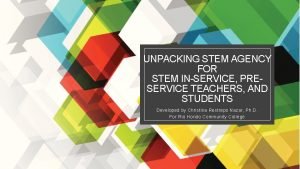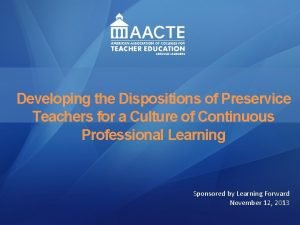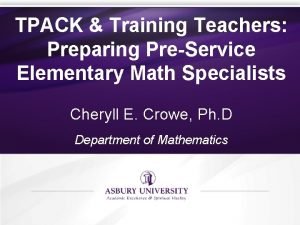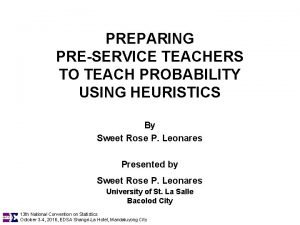Helping PreService Teachers Create Quality Education for English






































































- Slides: 70

Helping Pre-Service Teachers Create Quality Education for English Language Learners Created by Minda Morren López, Ph. D Associate Professor, Texas State University © 2015 Kappa Delta Pi, International Honor Society in Education

Welcome Take three minutes and briefly introduce yourself to the colleagues sitting on your right and your left. Share: • Name • University • Major • Interesting fact about yourself

Setting the Stage for Your Learning: Housekeeping Tasks Schedule • 3 -hour session this morning with break • 90 -minute lunch • 3 -hour session this afternoon with break Restroom Breaks • Please take care of yourself. If you need an extra restroom break during the session, quietly slip out of the room. Refreshments • Please feel free to enjoy refreshments during the workshop. Eat and drink quietly so that you do not disturb others.

Setting the Stage for Your Learning: Housekeeping Tasks, Continued Technology Use • Please silence cell phones, laptops, i. Pads, and other electronic devices. A participant manual has been provided so that you can take notes. We want you to be physically and cognitively present during the workshop so that you and your colleagues will gain the most from the workshop. Feel free to check your technology during the formal breaks and lunch. Questions • Please raise your hand if you have questions during the workshop. We welcome your thoughts and ideas. Side Conversations • Please refrain from holding side conversations. The workshop is designed to be very mentally and physically interactive. You will have many opportunities to talk and move.

Objectives Participants will understand how to support English Language Learners (ELLS) in their classrooms and schools. Together we will: • Assess and reflect on our own understandings and experiences related to language. • Learn about research and current thinking on language teaching and learning.

Objectives, continued • Understand federal and state laws, mandates, and practices to better serve our ELLs. • Understand the challenges for ELLs in schooling, including the implementation of linguistic and academic content. • Identify ways to meet the social, emotional, cultural, and academic needs of ELLs.

Part 1: What do I know about ELLs? Work with a partner to answer questions on the Anticipation Guide and think about your understanding of these concepts. Jot down how you came to know the information or form your opinion related to the questions on the Anticipation Guide. Then we will discuss our thinking and talk more about research.

Anticipation Guide

Anticipation Guides Purpose • Draw upon prior knowledge. • Recognize the effects of one’s own point of view in formulating interpretations of texts. • Engage all students in the exploration of new information by challenging them to critically think about what they know or think they know about a topic.

Anticipation Guides Purpose • Set a purpose for reading, even for those students who initially may not be engaged by the topic. • What else? Why does this activity aid in learning? How would this help ELLs?


What do you know about ELLs? Spend 5 minutes writing your responses to the following questions in your participant manual. There are no right or wrong answers. You will eventually share your thinking with colleagues at your table.

What do you know about ELLs? 1. What do you already know about ELLs and language acquisition? 2. Have you learned two or more languages or attempted to? Are you an ELL? Have you been friends with ELLs? What were those experiences like for you? 3. What did you learn from the Anticipation Guide that surprised you? 4. What questions do you have about ELLs or language acquisition? 5. What do you hope to learn during today’s workshop?

ELLs in the US: A brief history Background • Our country has had a varied approach to multilingualism and language education. Understanding the sociohistorical context helps us understand societal norms, mandates, and practices in schools today. Thought Questions • Directions: Review the answers to your questions from the previous section, “What do you know about ELLs? ”

ELLs in the US: A brief history Reading Assignment • Read the Brief History of ELLs excerpt. • As you read the passage, place a check mark next to the information that speaks to you, write comments that come to mind while reading the passage, or write questions that come to mind. • Be prepared to share your thoughts with your table mates.

Common Acronyms • Which of the following acronyms related to ELLs are you familiar with? Which ones can you define? AMAO BICS TESOL CALP CLD ELL DLL ELP ESL ESOL FES FLES L 2 LEP SDAIE ENL LES SIFE SIOP NES ELD AYP LFS LTELLS Bilingual/ESL Department 2014

Part 2: What is the Research on Language Learning? Language Acquisition Quick Write • Have you been around children acquiring their first language? • Have you learned/tried to learn another language? What was it like? Describe your actions, feelings, etc. • How do you think people learn languages?

Quick Write Purpose • Draws upon prior knowledge. • Allows all participants to formulate their thinking on a topic before they are asked to communicate their ideas with others. • Sets a purpose for reading or discussion, even for those students who initially may not be engaged by the topic.

Quick Write Purpose • Gives participants practice in writing their ideas related to an academic topic but does not require correctness or a set genre of writing (can be a list, stream of consciousness, complete sentences, etc). • What else? Why does this practice aid in learning? How would using this help ELLs?

Language Learning • Language is just one of the many ways we make meaning in every day life. Language is not learned absent of context. • Virtually all humans acquire a language (or more than one) before the age of 5. Some theorists believe we are hard wired for oral language (Chomsky) and only need to be in a language rich environment in order to learn language.

Language Learning • Globally, monolingualism is not the norm. The majority of people around the world are proficient in more than one language. • Some people learn two or more languages simultaneously, others learn them sequentially.

Language Learning • Language instruction in schools used to focus more on grammar, but in the past few decades the emphasis has been on communicative purposes or functions, authentic communication, and meaningful interactions.

Inferences of Language Learning Part 1: Understanding the Inferences • Read the inferences of language acquisition. These inferences are based on research regarding language acquisition and the purpose of this activity is not to debate them. • Look at the summaries. • Talk with your group about your experiences that align with these inferences and are related to first or second language learning.

Inferences of Language Learning Part 2: Implications for the classroom • With your group, write down what each inference means for classroom instruction. • How does this translate to teaching language in classroom settings?


The Silent Period • All learners of another language experience a period of time where they are not ready to communicate. This is to be expected. Students should not be forced to communicate. Krashen

The Silent Period • Students should be allowed to build up linguistic competence by active listening and need a supportive learning environment so they feel comfortable using language. Krashen

The Affective Filter Hypothesis • There affective or emotional elements that have an impact on the acquisition of language. • As educators, we want to lower the affective filter or the anxiety our students may experience in the classroom. • This is especially important in language learning situations and classrooms. In large part because language is such an integral part of who we are and our identities. Krashen

The Affective Filter Hypothesis • Anxiety: A lower level of anxiety is desired • Good Self-Image: Show you care and value the student and his/her cultural and linguistic background. Avoid corrections and/or embarrassing situations for the student • Interest and Motivation: Provide meaningful activities based on the student’s motivation and cultural background Krashen

The Input Hypothesis • It is the teacher’s responsibility to provide supports so that students can understand what teachers are communicating. • Some supports include visuals, gestures, modeling, slowing down our rate of speech, enunciating clearly, and explaining idioms, vernacular or academic terms. Krashen

Response to the Input Hypothesis the Output Hypothesis (Swain) • Output is a significant way for the learner to test what they know about a language • Learners pay attention to meaning first and then move to grammatical structure and they do this through “testing” their language by producing output and monitoring the responses to their language

The Monitor Hypothesis • Those who are acquiring language begin a process of monitoring their language through conscious corrections. • The more you know, the more you consciously monitor your language use. • Errors and error correction are signs of developmental processes and are positive. Krashen


Types of Language Proficiency According to Jim Cummins BICS (Basic Interpersonal Communication Skills) 1 -3 years to develop CALP (Cognitive Academic Language Proficiency) 4 -10 years to develop [Social Language] [Academic Language]

Social and Academic Language Proficiency Native English Speakers English Language Learners Social Language (BICS) P r o fi c i e n c y 2 y s ear Academic Language (CALP) P r o fi c i e n c y o 5 -7 y s r a e t p (u )* 0 1 *Typically 5 -7 years, if ELLs have had 2 -3 years of first language schooling in home country— 7 -10 years if not

BICS and the Language of the Content Areas 1. In your group, fill out the matrix-using vocabulary from the specific content areas. 2. Be prepared to share some of your answers with the whole group. There may be multiple answers for each vocabulary item.

The Language of the Content Areas BICS (Basic Interpersonal Communicati on Skills) The Language of Science The Language of Math The Language of Social Studies The Language of English/ELA small estimate plethora identical rules (your own)

BICS and CALP in the classroom: Word Maps

Academic Language • Cummins’ theory of BICS and CALP was important in helping educators recognize the complexities of language learning. • Our understandings of academic language continue to evolve and include not only the level of vocabulary, but also discourse. Discourse of a subject area includes the make up of sentences, grammatical structures, and overall perspective that is shared by that group or content area.

Reflection: Metacognition frame • In groups, brainstorm ideas that stood out to you from our discussion of research related to ELLs. What do you think are the most important takeaways? • Chart your ideas and create a Metacognition Frame. • Be prepared to share your frame with the larger group.

Metacognition Frame • I know that I know something about ______________. • First, ______________________. • In addition, ________________________________________. • Finally, _____________________. • Now you know what I know about _______________. Rothstein, A. S. , Rothstein, E. B. , & Lauber, G. (2007). Writing as Learning: A Content-Based Approach. Corwin Press: Thousand Oaks, CA.

Metacognition Frame Purpose • Helps cull out important points. • Scaffolds learning and summarizing. • Allows all participants to formulate their thinking on a topic before they are asked to communicate their ideas with others.

Metacognition Frame Purpose • Gives participants practice in writing their ideas related to an academic topic while supporting them (transition words, grammar are scaffolded). • What else? Why does this activity aid in learning? How would this help ELLs?

Part 3: What are some important considerations for programs and pedagogy for ELLs?

Programs for ELLs • There is no federal mandated program or instructional approach for ELLs. • As a result of Lau vs. Nichols and the Equal Educational Opportunity Act (EEOA) (both from 1974), each state must decide how they are going to meet the needs of ELLs. • We are still learning about the impact of the ESSA passed in December, 2015 and its ramifications on education for ELLs. The Department of Education may create new trainings and/or resources in coming months.

Programs for ELLs In 1981, a court case (Castañeda vs. Pickard) clarified the Lau and EEOA mandates, assuring that programs for ELLs are indeed adequate and based on sound scientific evidence.

Programs for ELLs The Castañeda standard mandates that programs for language-minority students must be: 1. based on a sound educational theory, 2. implemented effectively with sufficient resources and personnel, and 3. evaluated to determine whether they are effective in helping students overcome language barriers. (Del Valle, 2003)

Programs for ELLs Strategy: 3 W’s (What I Read, What’s in My Head, What My Partner Said) Text: Honigsfeld, A. (2009). ELLS Programs: Not one size fits all. What I Read What’s in my Head What my Partner Said

3 Ws Purpose • Helps readers “chunk” information. • Chunking makes a text less overwhelming. • Facilitates making connections (text to self, text to text, text to world, etc) • Allows all participants to formulate their thinking on a topic before they are asked to communicate their ideas with others, but then confirm meaning with their peers.

3 Ws Purpose • Gives participants practice in writing their ideas related to an academic topic but does not require correctness or a set genre of writing (can be a list, stream of consciousness, complete sentences, etc). • What else? Why does this activity aid in learning? How would this help ELLs?

Standards • Federal mandates have required states to have standards for instruction since 2009. However, the mandate is for content area standards and ESL is not a requirement. • TESOL (Teachers of English to Speakers of Other Languages) created ELL Standards in 2006. These are not mandatory but are guidelines for states and districts to follow. • Some states have their own standards specifically for ELLs.

Standards • The Common Core was adopted in 2009 by 45 states. There are no specific standards in the Common Core for ELLs but there is an addendum that states the needs of ELLs should be taken into account when implementing the standards (TESOL, 2013). • Recently, there have been several initiatives geared towards helping educators address the needs of ELLs, primarily English language proficiency.

Understanding your context 1. Read the policy brief provided to you. • As you read the passage, place a check mark next to the information that speaks to you, write comments that come to mind, or write questions you have. • Be prepared to share your thoughts with your table mates.

Understanding your context 2. Research what standards are in place in your state. • Does your state follow the Common Core? • Are there other initiatives related specifically to ELLs that your state has implemented? • What programs are in place for ELLs?

Part 4: How can I become a more effective teacher of ELLs?

Meeting the needs of ELLs Research has shown that effective teachers of ELLs address students’ affective, linguistic, and cognitive needs. • Affective –the affect, or emotional side of learning • Linguistic –the language or specific vocabulary and functions of language necessary to learn or communicate • Cognitive – the intellectual or content area subject matter that students must learn

“I do, we do, you do” • We will watch a video of a strategy. Think about how this strategy addresses the Affective, Linguistic, and Cognitive needs of ELLs. • As we are watching it, jot down your ideas: • What do you notice? • What does the teacher do to support ELLs in these three areas? I do, We do, You do Strategy

“I do, we do, you do” debrief

“Using sentence frames” • We will watch a video of a strategy. Think about how this strategy addresses the Affective, Linguistic, and Cognitive needs of ELLs. • As we are watching it, jot down your ideas. • What do you notice? • What does the teacher do to support ELLs in these three areas? Sentence Frames Strategy

“Using sentence frames” debrief

Meeting the needs of ELLs • Research also suggests that the most effective teachers of ELLs treat reading, writing, listening, and speaking as interconnected aspects of language and include them in as many lessons as possible. • Some students may be more advanced in their receptive skills (reading and listening) than in their expressive or productive skills (writing and speaking).

Meeting the needs of ELLs • Students may also demonstrate more proficiency in one area of language than another due to personality, cultural background, or individual preferences. • However, we should work to incorporate as many aspects of language as possible into each lesson, assuring that our students have time to practice language actively.

“Three step interviews” • We will watch a video of a strategy. Think about how this strategy meets the affective, linguistic, and cognitive needs of ELLs and also incorporates all four areas of language (reading, writing, listening, and speaking). • As we are watching it, jot down your ideas. • What do you notice? • What does the teacher do to support ELLs in these three areas? • How do the students engage in all four areas of language? Three step interviews strategy

“Three step interviews” debrief

Strategy sort • Now think about the various strategies we have used, read about, or watched in this training. • You will be given cards with the name of each strategy on them. • With your table group, sort the strategies in an open sort (you decide how they are to be sorted, into what categories). • Be prepared to share with the larger group how you sorted the strategies and why.

Sorting Purpose • Draws upon prior knowledge. • Open sorts are analytic in nature: participants analyze information and categorize. • Open sorts are also creative, there is no ONE right answer. It allows for multiple perspectives to be discussed.

Sorting Purpose • Teachers can better understand what students are thinking when students engage in open sorts, because categories are not given. • Great strategy for review. You are able to check understanding through a sort. • What else? Why does this activity aid in learning? How would this help ELLs?

Reflection • Take three minutes to write in your participant manual the most significant learning for you today. • What do you want to remember? • Share your ideas with a partner at your table.

• Please complete the written evaluation form and put it on the back table as you leave. • Your positive and negative feedback will help us to improve future Kappa Delta Pi ELL Workshop.

Helping Pre-Service Teachers Create Quality Education for English Learners
 Action verbs past present future tense
Action verbs past present future tense Kim kroll
Kim kroll Jika noel(create(q)) adalah 0 maka front(create(q)) adalah
Jika noel(create(q)) adalah 0 maka front(create(q)) adalah National association of special education teachers
National association of special education teachers Swot analysis of a teacher
Swot analysis of a teacher Wisconsin council of teachers of english
Wisconsin council of teachers of english Elt teachers club
Elt teachers club Perform quality assurance
Perform quality assurance Pmp quality management
Pmp quality management Pmbok quality management
Pmbok quality management Quality assurance cycle in nursing
Quality assurance cycle in nursing Quality improvement vs quality assurance
Quality improvement vs quality assurance Basic quality concepts
Basic quality concepts Two quality gurus
Two quality gurus Crosby's fourteen steps to quality improvement
Crosby's fourteen steps to quality improvement What is tqm
What is tqm Kontinuitetshantering i praktiken
Kontinuitetshantering i praktiken Typiska drag för en novell
Typiska drag för en novell Tack för att ni lyssnade bild
Tack för att ni lyssnade bild Returpilarna
Returpilarna Shingelfrisyren
Shingelfrisyren En lathund för arbete med kontinuitetshantering
En lathund för arbete med kontinuitetshantering Kassaregister ideell förening
Kassaregister ideell förening Personlig tidbok för yrkesförare
Personlig tidbok för yrkesförare Anatomi organ reproduksi
Anatomi organ reproduksi Densitet vatten
Densitet vatten Datorkunskap för nybörjare
Datorkunskap för nybörjare Stig kerman
Stig kerman Hur skriver man en debattartikel
Hur skriver man en debattartikel Magnetsjukhus
Magnetsjukhus Nyckelkompetenser för livslångt lärande
Nyckelkompetenser för livslångt lärande Påbyggnader för flakfordon
Påbyggnader för flakfordon Kraft per area
Kraft per area Svenskt ramverk för digital samverkan
Svenskt ramverk för digital samverkan Jag har nigit för nymånens skära
Jag har nigit för nymånens skära Presentera för publik crossboss
Presentera för publik crossboss Argument för teckenspråk som minoritetsspråk
Argument för teckenspråk som minoritetsspråk Vem räknas som jude
Vem räknas som jude Treserva lathund
Treserva lathund Epiteltyper
Epiteltyper Bästa kameran för astrofoto
Bästa kameran för astrofoto Cks
Cks Programskede byggprocessen
Programskede byggprocessen Mat för idrottare
Mat för idrottare Verktyg för automatisering av utbetalningar
Verktyg för automatisering av utbetalningar Rutin för avvikelsehantering
Rutin för avvikelsehantering Smärtskolan kunskap för livet
Smärtskolan kunskap för livet Ministerstyre för och nackdelar
Ministerstyre för och nackdelar Tack för att ni har lyssnat
Tack för att ni har lyssnat Referat mall
Referat mall Redogör för vad psykologi är
Redogör för vad psykologi är Stål för stötfångarsystem
Stål för stötfångarsystem Tack för att ni har lyssnat
Tack för att ni har lyssnat Borra hål för knoppar
Borra hål för knoppar Orubbliga rättigheter
Orubbliga rättigheter Formel gruplar
Formel gruplar Tack för att ni har lyssnat
Tack för att ni har lyssnat Rita perspektiv
Rita perspektiv Verksamhetsanalys exempel
Verksamhetsanalys exempel Tobinskatten för och nackdelar
Tobinskatten för och nackdelar Toppslätskivling effekt
Toppslätskivling effekt Mästar lärling modellen
Mästar lärling modellen Egg för emanuel
Egg för emanuel Elektronik för barn
Elektronik för barn Kvinnlig mantel i antikens rom
Kvinnlig mantel i antikens rom Strategi för svensk viltförvaltning
Strategi för svensk viltförvaltning Kung dog 1611
Kung dog 1611 Indikation för kejsarsnitt på moderns önskan
Indikation för kejsarsnitt på moderns önskan Romarriket tidslinje
Romarriket tidslinje Tack för att ni lyssnade
Tack för att ni lyssnade Vilket tal pekar pilen på
Vilket tal pekar pilen på
